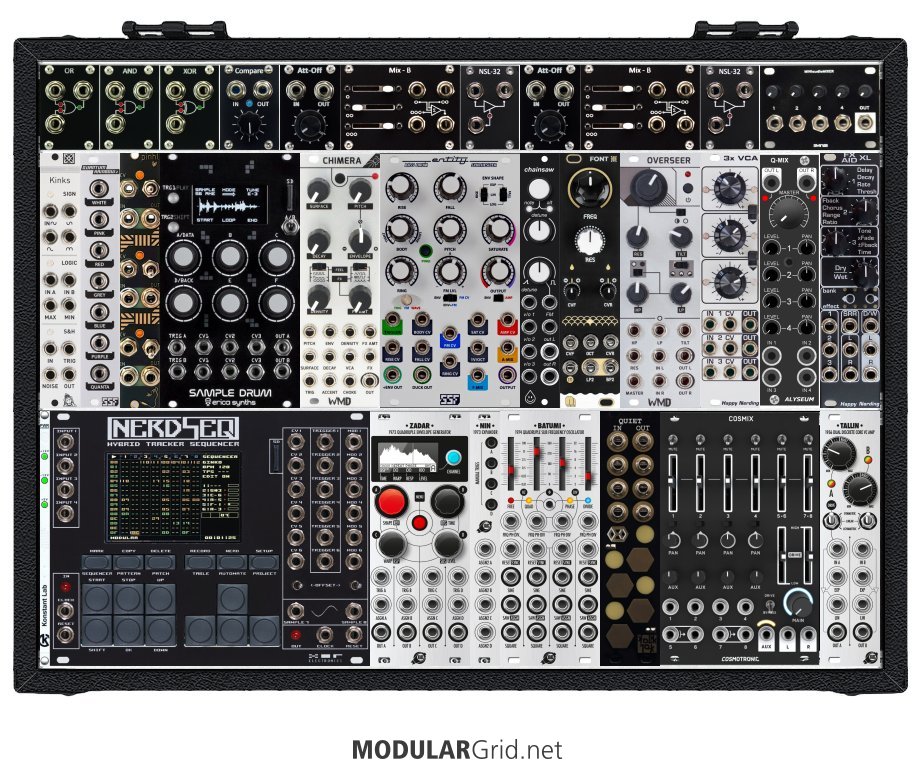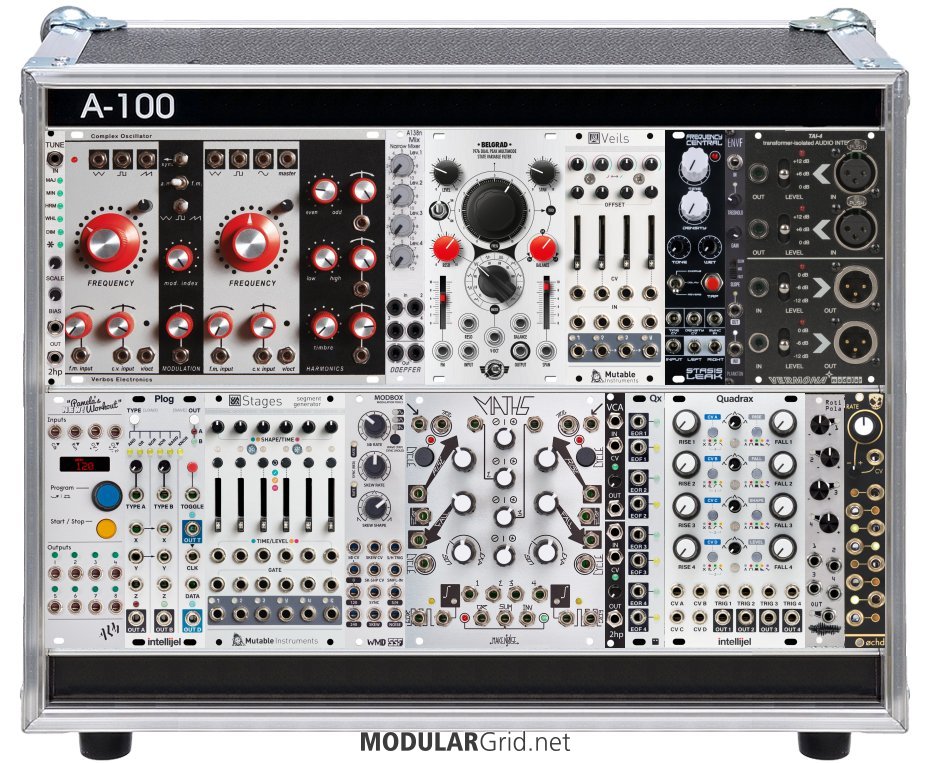Had some free time, decided to keep myself out of trouble by banging on this:

I decided to see if there were some stronger directions to go in with this. Turns out, there were!
First up, "voice" and "mod/control" are now separate (for the most part). I filled the tile row with "original" format tiles, because that allowed some major functional improvements. The logic gates on the left are to let you tamper with the gate/trigger signals coming off of the Nerdseq. There's also a comparator, which will allow you to pick off a gate based on LFO or EG signal levels, then add that to the timing mayhem. After that, you see two groups of attenuverter/offsets with a DC-coupled mixer and a DC-coupled linear VCA. Those are for messing with modulation signals...mixing, polarizing, imposing modulation, that sort of thing. And the final 4-in mixer is for audio, in case an extra mono sum is needed.
Note that I was able to jam a LOT of the standard tiles in that row...enough that it opened up a few things elsewhere. The Intellijel tiles are nice, to be sure...but the standard ones offer loads of "primitives", basic circuits that allow you to build up more complex subarrangements (like that DC mixer arrangement).
First 3U row: I shifted the Kinks to here to take advantage of the noise module added next to it. The Noise Rainbow there is supposed to be paired with the triple passive LPG next to it. Result: three more noise/filter-based drum sounds with those nice vactrol transients...you don't even really need to feed 'em envelopes, just fire 'em with the Nerdseq's outputs for rapid-fire percussives. Then...SampleDrum, Chimera, Entity, Chainsaw, Font, just like before...then we run across an Overseer VCF. The idea is ergonomic here; the Chimera is largely the same as the C4RB0N, minus the waveshaping (which you can easily do elsewhere, such as by running an audio signal to the SIGN section of the Kinks), but offers a few additional control tricks AND...it's larger. Since the main knobs that synthesists constantly tweak are usually VCF cutoffs, by going to this, I was able to open up the space around it AND the Font, making that playing method MUCH easier. 3xVCA next...then an Alyseum QMix, which gives you four mono ins with panning and a master trim, followed by the FX Aid XL...although if that works better with the main output mixer, it can be swapped with the Tallinn below.
Second 3U row: The little sliver at left is a Konstant Labs PWR Checkr...lets you keep tabs on the power rail performance. Very useful. Nerdseq next, then the Zadar and its expander. And then, yep, I had room to add a Batumi! This now gives you four more LFOs to keep the sounds moving and interesting. Got rid of the upside down mutes, went with Folktek's Quiet instead...for one thing, the form factor is right now, and also, the touchpads are lots more responsive than the buttons on the earlier version. Only one of these, though, and it's mainly for on/off control over CV/modulation paths. The AUDIO muting is on the Cosmotronic Cosmos stereo mixer, which has four mono ins with pans, two stereo pair ins, AUX send and stereo return, AND a nice overdrive that allows you to "crunch" the mix coming off of this...and yes, it does that selectively, since you can overdrive both stereo channels, or just one at a time if you want to run the Cosmos as a dual mono. And the Tallinn makes up the end of the row, for dynamic control of the Cosmos output.
Removed things: the Links (no real need for buffering in this, and it's cheaper to just use inline mults with that being the case), the Pico DSPs, the Matrix Mult, the Peaks, etc...there were just better ways of doing these things, and once the tile row got populated it started becoming apparent where to cut things, and what could go into the freed-up 3U space.
Now, as for the case...well, this is where problems crop up. Finding cases off the shelf that have the Pulplogic tile row in this size is not easy. You could go with rack rails and mount everything in a Gator or SKB road case...an 8U one would allow space for a power conditioner (lighted, even) on top, and this could allow you to switch your system on via that, leaving all of the DC supply electronics INside the case. And, in fact, this is probably far cheaper (and more practical) than the other options, which involves locating a case that either has the Pulplogic row (not easy) or building a bespoke case with it (not cheap). Perfect Circuit has the 4U Pulplogic rack frames, and for the other 3U, you can use the Tiptop Happy Ending or whatever works there. It's sort of halfway between totally custom-built and off the rack solutions, and it seems like it might be a proper solution here. The other nice thing about the rack frames is that you can CHANGE the row order and put the tile row in the center, where it would work better and make a helluva lot more sense.


